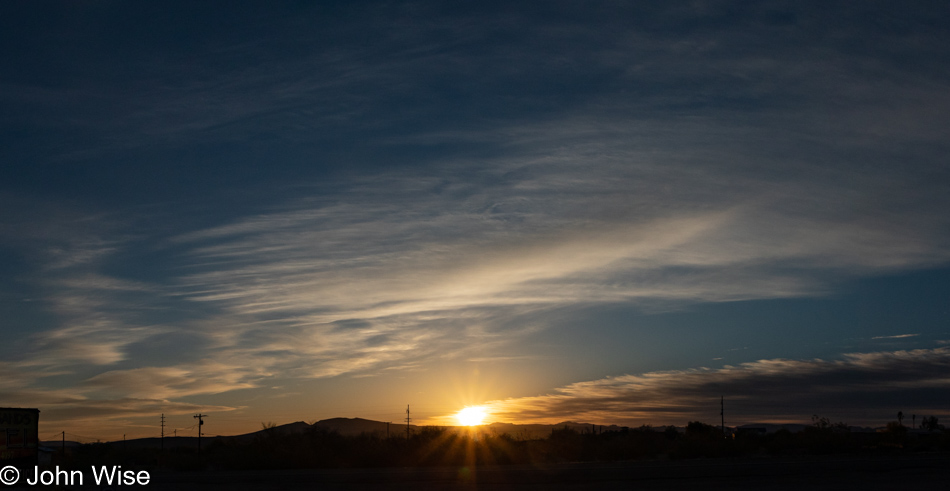
A slow day in the Desert Southwest started with the sun pouring into our east-facing window. Like an alarm clock hammering at our ears, the light of day insists that sleep is over. Into the morning we go.

After using those supplies of the hygienic type we secured last night, we started our journey south. Ajo, though it means garlic in Spanish, is no place for culinary delights by a long shot. Just getting breakfast is a chore. Likely due to the carnage of two years of pandemic, Google and the business listings of Ajo are out of sync. Luckily, we found Oasis Coffee at the main square, where we were able to get some decent coffee, a bagel for Caroline, and a bacon egg panini for me. Behind the wife was a gaggle of Brits that we learned were also heading down to the national monument; we were determined to beat the crowd, so it was time to drop the pen, go find some water, and point the car towards the trail. That was until Caroline thinks “bathroom” but finds half a dozen of those gray-haired people of English descent already in line ahead of her; she’ll just have to pull up a tree or cactus somewhere south of here.

Starting our drive south of Ajo, I was wondering why a place would be named after a herbaceous bulb related to the onion that doesn’t seem to be related to this town in any way. Wikipedia came to the rescue by informing us that Ajo might have gotten its name from the similar-sounding Tohono O’odham word for paint (oʼoho). As for Tohono O’odham, they are the original dwellers on these lands, and their name means Desert People.
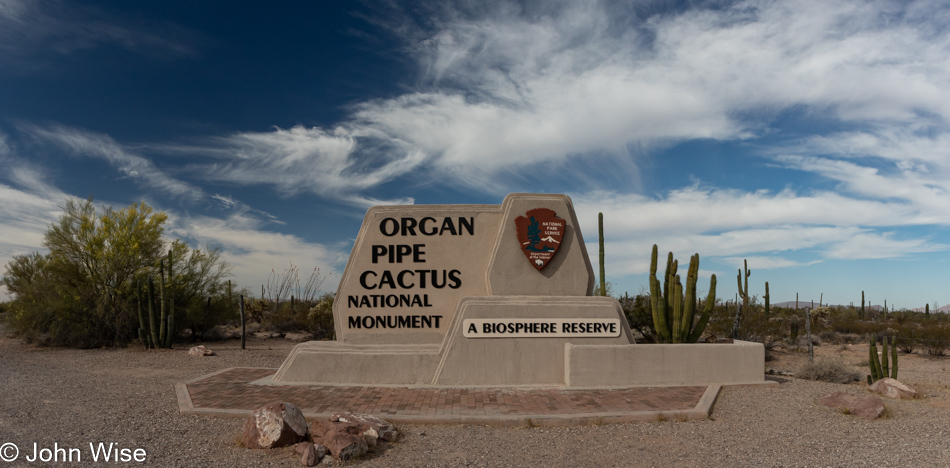
Search out the extraordinary and be prepared to be surprised. Here we are at Organ Pipe Cactus National Monument down in a tiny corner of Southern Arizona, but that is deceiving as it turns out that this desert outpost with very few roads is more than 12 times bigger than Paris and almost 4.5 times bigger than Munich. Yep, it’s that big! There are about 101 miles (162km) of dirt roads through the monument; of those, we’ll only be able to visit 21 (34km) today.

The one paved road through the park is an artery traveling between Mexico to the south and Why, Arizona, and points beyond to the north. Our first stop will be the visitor center to pick up the Junior Ranger booklet so Caroline can nab a badge from this park. As it turned out, my wife was going to have to step up to adulting as this national monument offers a “Desert Ranger” program for non-kids.

The first question has Caroline wishing for the Junior Ranger booklet where she can draw cute pictures and write poetry because asking her to describe and diagram the genetic mutation that leads to cristate cactus formations has her stumped. That is until I offered her the explanation that this is a defect in the apical meristem and as far as the diagram was concerned, she was on her own.
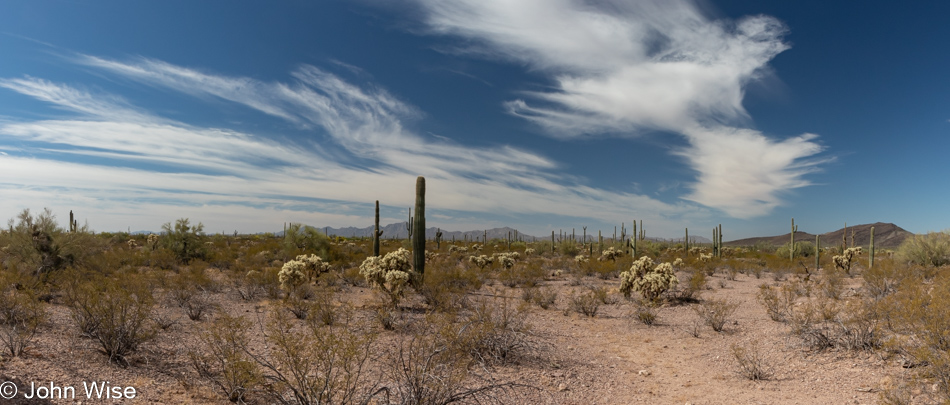
Our wish during this visit to Organ Pipe Cactus National Monument was to make our way over the 41-mile-long Puerto Blanco Drive that would have brought us past Quitobaquito Springs (closed for restoration work), but the ranger informed us that there are sandy parts of the road and that at a certain point, we will be limited to one-way traffic so turning around becomes impossible should we hit a part of the road we’re not comfortable negotiating.
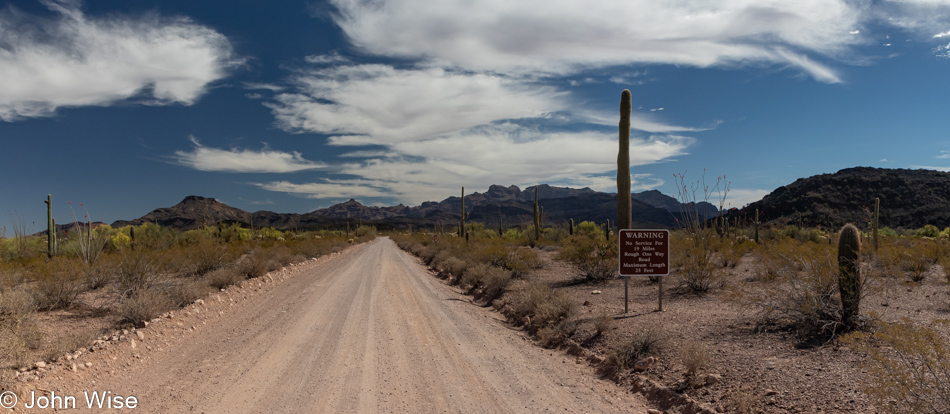
Instead, we are heading up the popular Ajo Mountain Drive.

What was the lesson learned from visiting this particular organ pipe cactus that was a short walk away from the gravel road? For me, it was I should have worn my hiking boots as random unidentifiable cactus needles are able to penetrate the rubber soles of my walking shoes, and while I didn’t need pliers to remove them, it’s a rude moment when a needle meets flesh.

I would like to imagine that nearly anyone looking at this image would be able to figure out the reference to organ pipes.
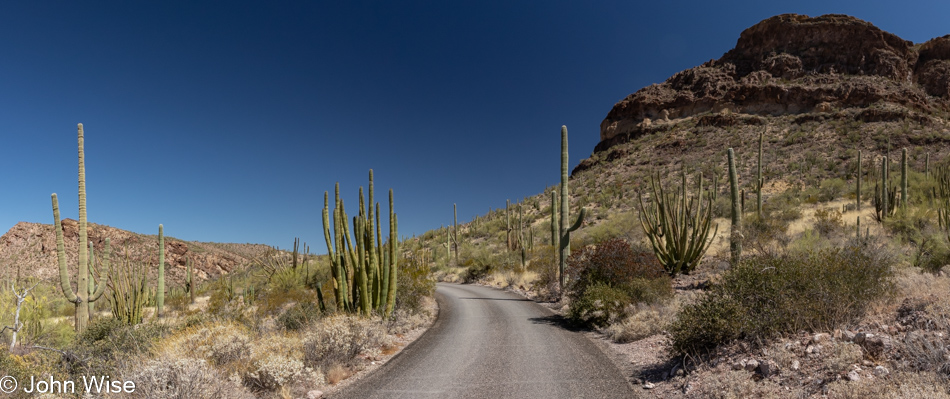
After a good stretch of washboard dusty dirt road, we run into some paved sections that are always delightful as, for a couple of minutes, our car is turned into the greatest luxury ride ever.
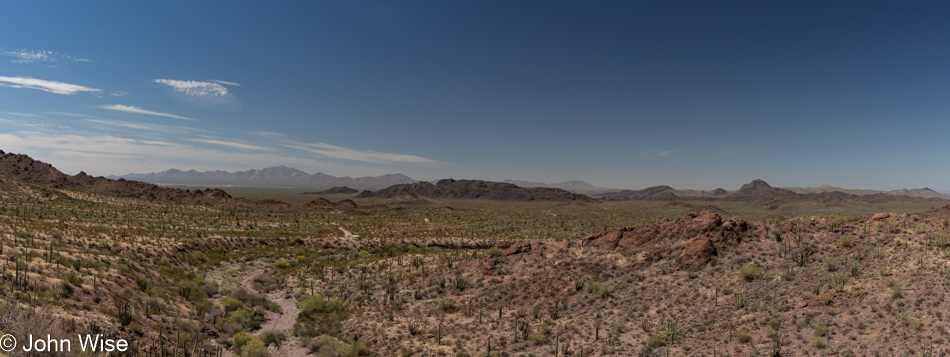
Guess how many cars have passed us at this point? Mind you that we’ve already been crawling around out here at a snail’s pace for a good hour. Well? The answer is NONE!
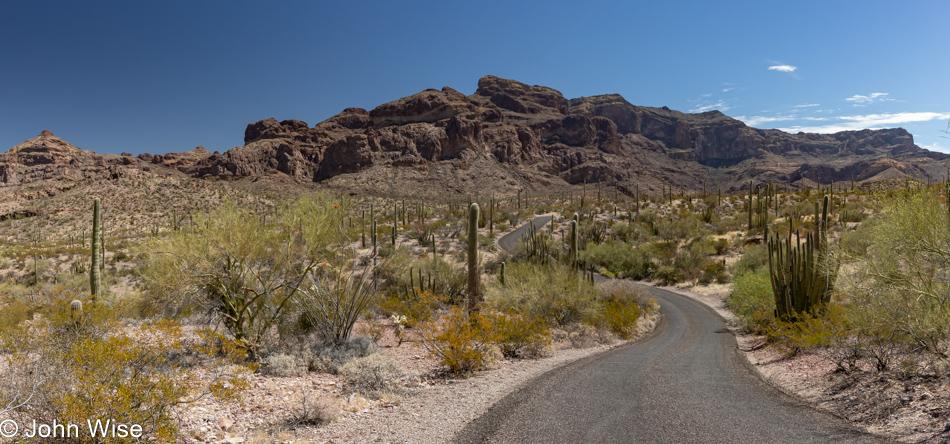
E-bike rentals here at the park would be ideal as the 21 miles of this road are too much to walk, but the car is allowing us to drive too fast. Being realistic, the argument against e-bikes could easily be made that most visitors are only interested in getting a glimpse of things the quickest way possible.

The Desert Ranger booklet points out that standing right here should be the largest organ pipe cactus easily accessible to those driving by, but all we found were these whale-like looking skeletal remains of what once was the said cactus.
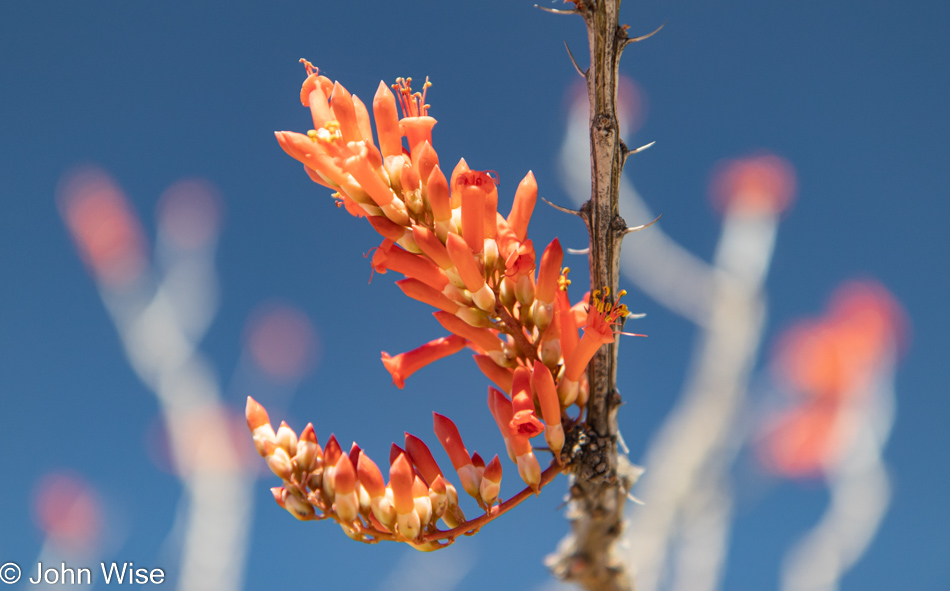
The ocotillos are in bloom, and why it took me so many years to learn the details of this semi-succulent plant is beyond me. First of all, the name is Spanish for Little Torch, which should be obvious enough from the color and shape of the flowers. This plant that is able to live for nearly 60 years is related to the boojum tree. Finally, the fresh flowers are edible and can be used in salads; when dried, they can be used as herbal tea.

We’ve reached Arch Canyon, and the one and only hike we’ll do out here today. Look closely at the big blue spot in the rocks, and just above that is a minuscule, fragile-looking second arch. I’ll just go ahead and tell you now: the trail that would have taken us up close and personal with the arches eventually would get too hairy for me, so this will be the best photo of it that I was able to take, but we wouldn’t know that until we got deeper into the canyon.
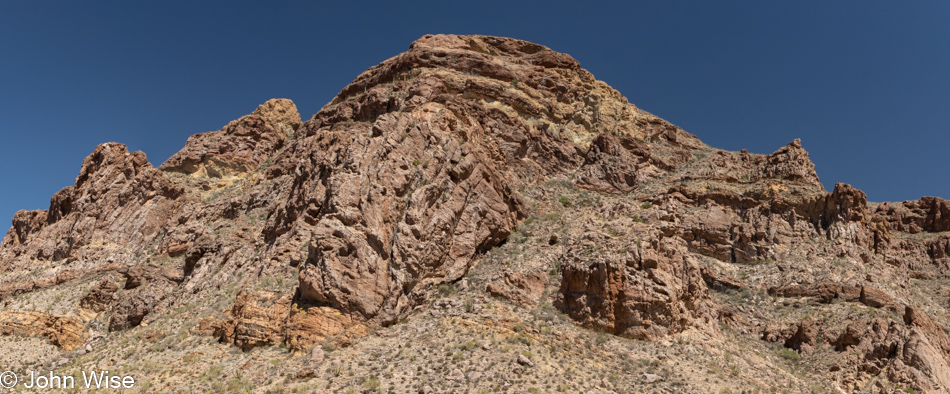
So, we started our pleasant hike over a well-groomed trail thriving on the exquisite beauty and solitude out here.
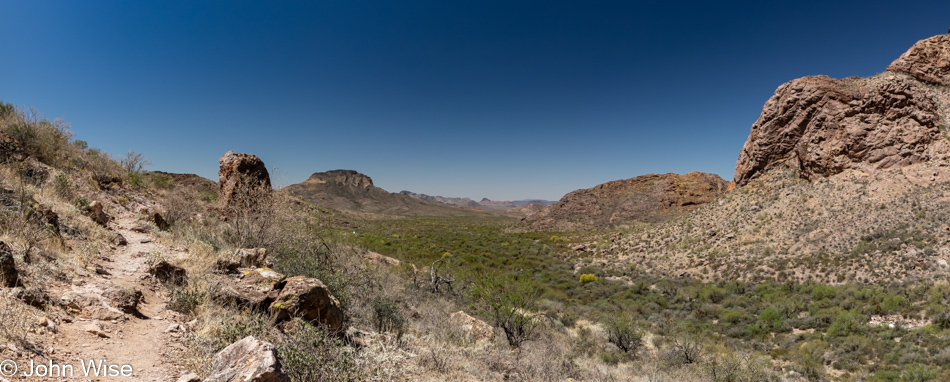
Looking back on the way we came.
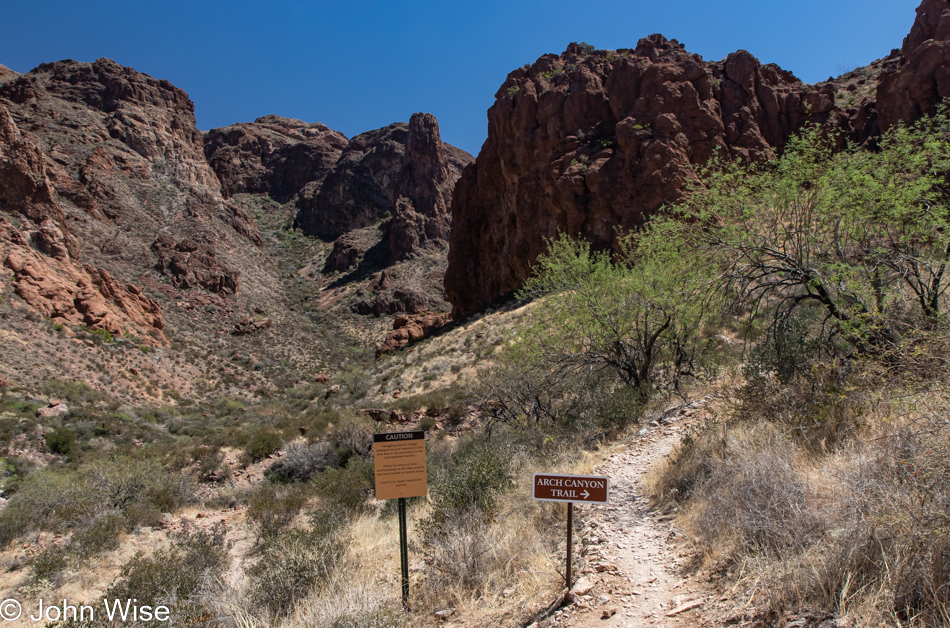
It was just around this corner where a steepish ascent up some slick rock marked by cairns would have taken us up the mountain for a more intimate encounter with the arches, but like I said…

As we turned around just beyond those signs, one of them warning us about immigrants and traffickers, I spotted the smallest arch I’d ever seen. About 25 feet overhead was this tiny opening I don’t believe a hand could have fit through.

Another organ pipe cristate, also referred to as a crested cactus, was found, but the saguaro cristate described in the booklet couldn’t be found; maybe it is now gone.

I can’t remember ever seeing this cristate mutation in the Phoenix area; I wonder if this is an environmental factor due to elevation, weather, or soil chemistry.

Come to think about it, why don’t these organ pipe cacti call the desert up in Phoenix home? From Phoenix down to the Mexican border and beyond, these lands are all part of the Sonoran desert. As a matter of fact, the Sonoran desert extends 260 miles south to Guaymas, Mexico, and yet, saguaro cacti are only native to Arizona. Of course, the internet has all the right answers. It turns out that organ pipe cacti require predictable, warm-season rains and rocky soil, and the Phoenix area doesn’t meet those requirements.

Flowering jumping cholla, also known as teddy bear cholla, is what’s leaving the needles on the ground I’m stepping on; this is my best guess.

After nearly 5 hours in the monument and some serious noodling to figure out the physics, chemistry, biological function, and symbiotic relationships between various plants and creatures, it was time to turn in the 40-page questionnaire that tested Caroline’s knowledge that might allow her to become a Desert Ranger and as you can see for yourself at her swearing-in ceremony, she is now a fully qualified Desert Ranger with distinction. She earned this extra title for explaining how cycles of the moon influence the hydrological function of organ pipe cactus and the volume of water exchanged with the environment during these transitional times. Yep, she’s that smart…O estoy tan lleno de mierda.
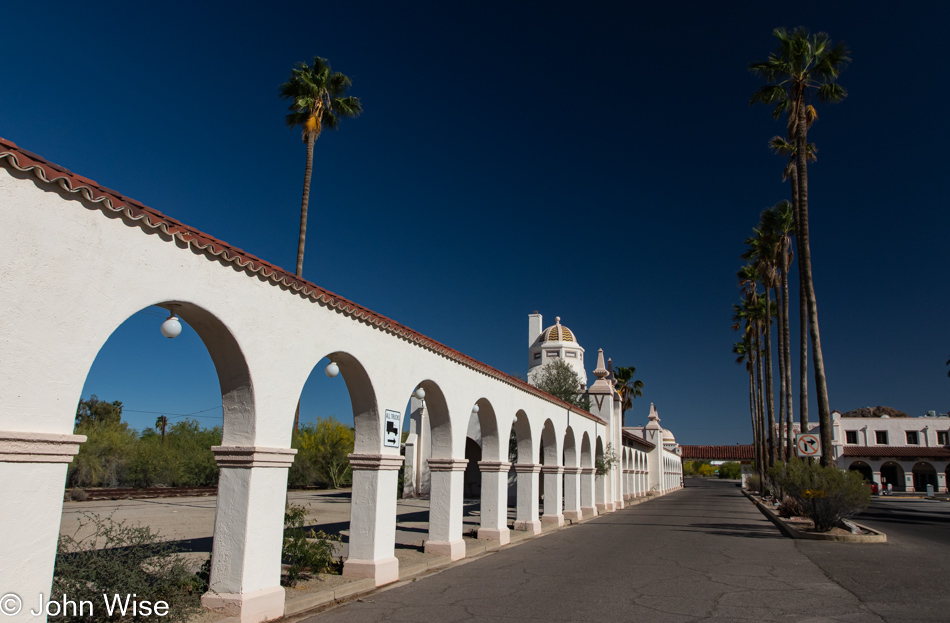
So, from the visitors center, we were supposed to head down to Puerto Peñasco, Mexico, but things didn’t work out that way. The proverbial confluence of events conspired against our inner Schweinehunds, and we headed north instead of our dreamed-of Pollos Sinaloa El Angel for lunch near the ocean. Giving up that grilled chicken had us feeling defeated as that really was the only reason for driving hundreds of miles into the desert at the cusp of summer, that and the Carne Asada we enjoyed yesterday.
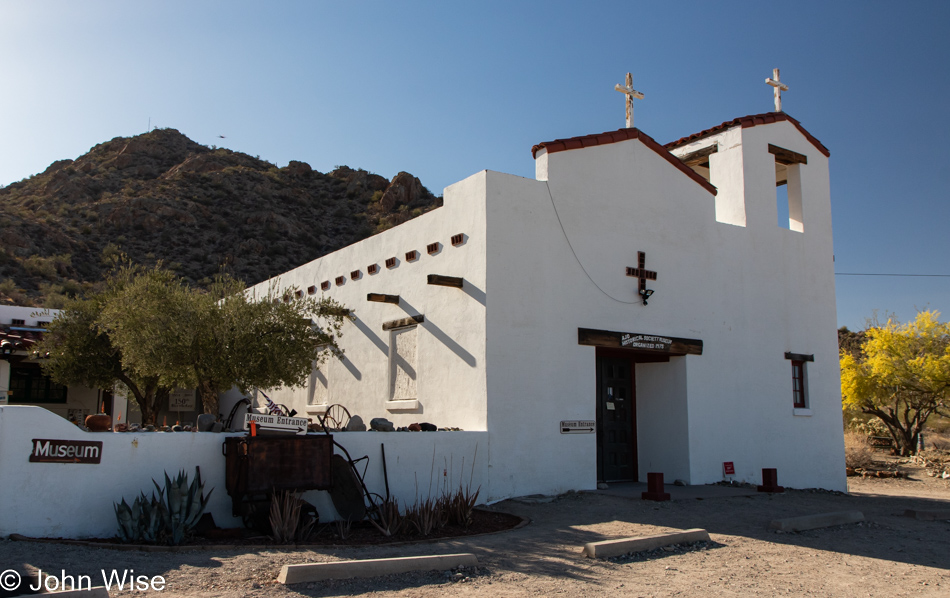
Seriously though, we were warned that passing through Sonoyta on the border carried risks of police trying to fleece tourists passing through for any perceived infraction; one anecdotal story from the ranger at the park of having his phone stolen down in Rocky Point by armed men, and then the admonition to be very aware of the U.S. side of the border closing at 8:00 p.m. and the heavy traffic on holiday weekends. Sonoyta hotels often sell out due to travelers after waiting hours in line being turned away when the border closes. Too much hassle in our book, so we returned to Ajo, sat down for lunch followed by a coffee back at Oasis, and then drove across the way to visit the closed Ajo Historical Society Museum.

The rusting hulk of a Kilbourne & Jacobs Automatic Air Dumping Car is a relic of the mining industry made by a company that was founded in 1881 and went bankrupt by 1923. I think this logo plate weighs more than the bumper on our Kia.

This is the train car from just above.
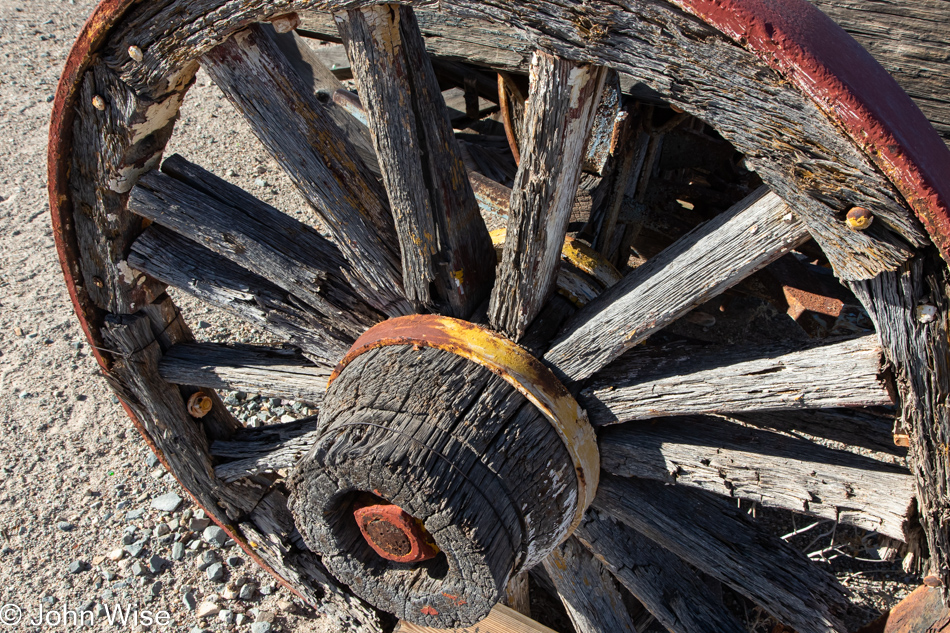
I was considering the effort to restore that decaying train car, heck we see people on YouTube restoring anvils, lanterns, knives, planes, cars, etc., well restoring that car would be interesting to me. This got me thinking of restoring the 100-year-old wood cart this broken wheel is attached to, so I researched the world of wooden wheels used for these types of projects, and it turns out there’s a market out there. I’d imagine it is a small one, but for between $300 and $1000 apiece, people are able to acquire wood wheels for their covered wagons, carriages, cannon wagons, and vending carts that require an old-world appeal.

Ajo was the site of the first open-pit copper mine in Arizona, for what that’s worth.

The Ghost Figures of Ajo are sculptures distributed around town by Val Uschuk, who seems to spend her time between Durango, Colorado, and out here in the remote desert. The pieces are worth seeking out, and when we are in Durango in August, we’ll be sure to keep our eyes open for the ones that are installed there.